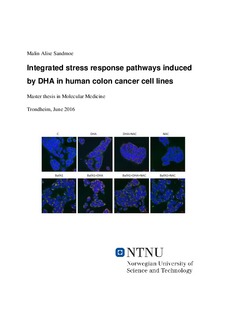| dc.description.abstract | Estimates show that 95% of all cancers can be attributed to environmental factors, and diet represents 30-35% of this. The omega-3 polyunsaturated fatty acid docosahexaenoic acid (DHA, 22:6 n-3) is an essential fatty acid that has been shown to have anticancer properties. Many molecular mechanisms have been proposed to be involved, including increased oxidative stress, alterations in membrane composition or function, changes in eicosanoid production, and regulation of gene expression. Our group has previously shown that ER stress is induced in response to DHA in several human colon cancer cell lines. ER stress is a part of the integrated stress response, which responds to various types of cellular stressors and coordinates a response throughout cellular structures. The aim of this study was to elucidate the molecular mechanisms involved in the anticancer properties of DHA, with special focus on pathways involved in the integrated stress response. The two human colon cancer cell lines DLD-1 and LS411N were chosen based on their different sensitivity to DHA treatment and the fact that they are cultured in the same growth medium. DHA-effect on cell growth was measured by cell counting. About 40% growth inhibition was observed after 48 h in DLD- cells, whereas LS411N cells showed very little growth inhibition. Co-treatment with the antioxidants BHA and BHT did not counteract the growth inhibition, but growth inhibition was partly counteracted after NAC treatment, indicating a role of oxidative stress in DHA-induced growth inhibition. Protein expression analyses of ER-stress- and Golgi-stress-related proteins showed that ER stress was induced DLD-1 cells, but not in LS411N cells. Golgi stress was not induced in either cell line. Mitochondrial oxidative stress and reactive oxygen species (ROS) were measured by flow cytometry, and results showed an increase in both mitochondrial oxidative stress and ROS levels. Whereas NAC did not reduce mitochondrial oxidative stress, it did reduce ROS levels. The fluorescence intensity of the autophagy marker Cyto-ID was measured by flow cytometry to measure autophagic structures in the cells. Results showed an increase in autophagy after DHA treatment in DLD-1 cells. Protein expression analyses showed an increase in autophagic flux in the same cell line. Autophagy levels increased in LS411N cells, but an increase in autophagic flux was not observed. The basal autophagy level in LS411N cells was found to be 2.5 fold higher than in DLD-1 cells, indicating a possible connection between basal autophagy levels and DHA sensitivity. DLD-1 expresses mutant p53, while p53 is not expressed in LS411N cells. Protein levels of p53 in DLD-1 cells were affected after DHA treatment, but SiRNA-mediated knockdown of p53 in DLD-1 cells did not affect the DHA sensitivity. This IX suggests that DHA sensitivity does not depend on p53 status. Together, results suggest that oxidative stress and pathways of the integrated stress response are involved in DHA-induced growth inhibition and that autophagy levels are important for the DHA sensitivity of colon cancer cells. | nb_NO |
